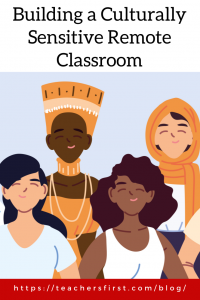Teachers and students were thrust into remote learning situations with little to no preparation at the end of the 2019-2020 school year. Many instructional programs were able to carry over the relationships and routines established in the physical classroom to the online environment. Teachers worldwide worked to keep the connections established in face-to-face experiences in order to best meet the students’ needs.

The start of the 2020-2021 school year yielded yet another challenge. A critical element was missing as many teachers and students began the year remotely without ever meeting face-to-face to establish relationships and connections. A culturally sensitive classroom teacher responds to students’ unique social, emotional, and academic needs through experiences they provide. Our classrooms have moved online during the COVID-19 pandemic, which has increased the challenge of fulfilling a teacher’s responsibility to provide a culturally sensitive learning environment.
Zaretta Hammond is a teacher educator and the author of Culturally Responsive Teaching and The Brain: Promoting Authentic Engagement and Rigor Among Culturally and Linguistically Diverse Students. On page 54 of her book, Hammond writes, “The philosopher Lao Tzu said that the journey of a thousand miles begins with the first step, and becoming an effective culturally responsive teacher is a long journey.” The activities posted below will help you take the first steps of your journey to build a culturally sensitive remote classroom.
Background Knowledge
Surveys created in Google Forms (reviewed here) are a great way to collect background information on your students. Simply collecting and curating the information, however, isn’t enough to engage and empower the students. In an Edutopia article on culturally responsive teaching in distance learning, Hammonds writes that educators can guide students to connect what they’re learning in classes to that background knowledge. “Asking students to reflect on and share what they observed or learned in a video or audio note can reinforce the knowledge gained.” PearDeck (reviewed here) is another digital resource to collect background information to connect with your learners.
Student Names
Mispronouncing a student’s name can have a lasting impact on the relationship with your students. Students can state their first and last name and share information about their background using Flipgrid (reviewed here). Flipgrid also has a mic-only feature to be culturally sensitive to students who are unable to record video. Pronouncing students’ names correctly is a vital component of culturally sensitive teaching. This activity helps students feel included and respected.
Choices
Providing students choices on how they can demonstrate their knowledge of learning objectives allows them to showcase their identity as a learner. Visit our OK2Ask archive to learn how to engage and inspire your students with choice boards for differentiation. It’s also essential to provide choices for how the students access the content. Our post from May 2020, “Low-Tech and No-Tech Strategies for Remote Learning,” offers tips for engaging all students. In your surveys to gain knowledge about your students, include questions to help you engage the learner with options for how to connect with the content. For example, students without Internet access may need paper copies delivered to their homes.
Feedback and Communication
Timely feedback as students work on learning experiences is also imperative to their success. Focus on the positives and encourage students to take risks to promote an inclusive environment. Feedback also champions a welcoming environment. Social-emotional check-ins provide an opportunity to learn more about students’ interests and well-being.
Remote learning environments present new opportunities to connect with our students and consider their identities as learners. Affirming and validating students’ identities and being intentional with actions to commit to culturally sensitive teaching practices provide the best possible learning experience for all students. How are you engaging your students’ cultural strengths during remote learning? We would love to hear your thoughts and teaching ideas – be sure to share them in the comments below.

